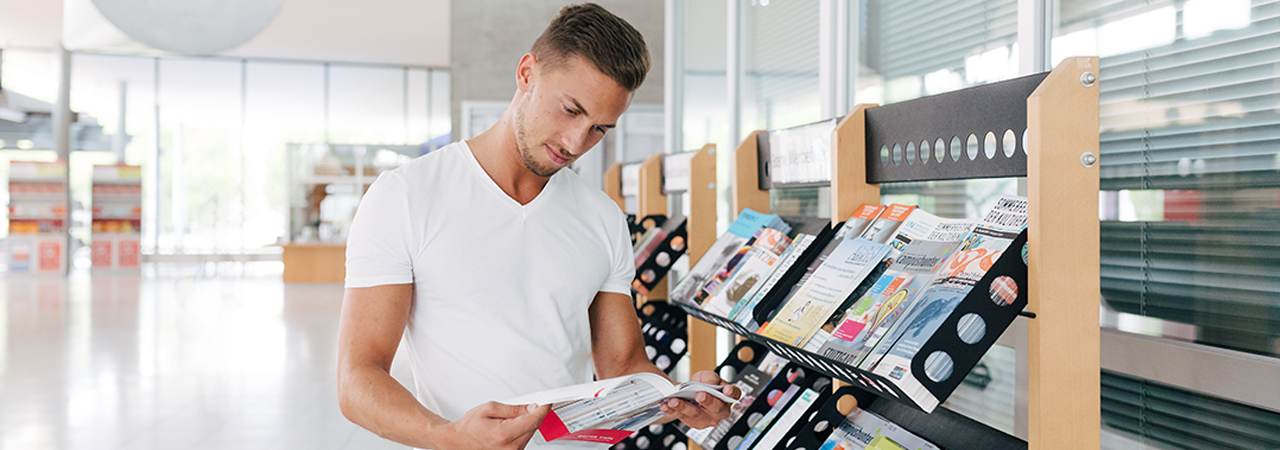119320a User Interface Design
| Zuletzt geändert: | 19.05.2022 / von Carlsburg |
| EDV-Nr: | 119320a |
| Studiengänge: |
Mobile Medien (Bachelor, 7 Semester), Prüfungsleistung im Modul User Interface Design
in Semester
4
Häufigkeit: unregelmäßig Mobile Medien (Bachelor, 7 Semester), Prüfungsleistung im Modul User Interface Design in Semester 3 Häufigkeit: immer Studienübergreifendes Angebot - Minors, Prüfungsleistung im Modul User Interface Design in Semester 1 Häufigkeit: immer Studienübergreifendes Angebot - Minors, Prüfungsleistung im Modul User Interface Design in Semester 1 Häufigkeit: unregelmäßig |
| Dozent: | Dimitri Hoffmann |
| Sprache: | Englisch |
| Art: | Flipped Classroom |
| Umfang: | 4 SWS |
| ECTS-Punkte: | 5 |
| Workload: | 150 hours Incl. the following assignments: A1: Domain Analysis & Presentation of Domain Analysis A2: Functional Design A3: Graphic Design Brief A4: Evaluation A5: Click Prototype |
| Inhaltliche Verbindung zu anderen Lehrveranstaltungen im Modul: |
- 119103a Grundlagen der Mensch-Computer-Interaktion - 119440a Usability Engineering - Please note that 119660a User Experience Design is a follow-up Lecture for UID. You need to complete UID before UXD. |
| Prüfungsform: | |
| Bemerkung zur Veranstaltung: | Teilnehmerbeschränkung Unterrichtssprache Englisch |
| Beschreibung: |
In this course we use a so-called flipped classroom method. This method is based on the basic concept of integrated learning. Here, the exercises and the teaching of the material are interchanged in that the learning content is worked out by the learners at home and the application is reflected on in class. The theoretical learning units are released online via Moodle on a weekly basis. To comply with the contact restriction of the Hochschule der Medien, we will split this course into groups at the kick-off event: . In this seminar students will apply a iterative User Centered Design (UCD) approach: • In this seminar students will form teams (agencies) and develop a high-fidelity prototype applying a user centred design approach. The Goal (and assignment) of this seminar will be a creative self-explanatory click prototype as well as a state of the art design specification for that prototype. Focusing of the User Interface Design (UID) this seminar will entail: User Interface Design Principles, Design Patterns -Conceptual Design: - Domain Analysis (Competitive & State of the Art Analysis) - Environment Analysis - Personas - Context of Use - Requiremetns Analysis Funktional Design - Scribbles (Paper Based) - Wireframing (Balsamiq) - Mock-Ups & Storyboards •Graphic Design Principles (GUID) - Mock-Up (Photoshop Exercise) Interaction Design - Enabeling Habtics- Design interactive transitions. •Prototyping: - High- & Low-Fidelity / Horizontal & Vertical Prototypes •Evaluation - Eye Tracker Tests (SMI System) Documentation: - State of the Art Specifications Seminar GOALS : -Appreciating a UCD approach and all necessary steps for involving a user into design iterations. -Understanding commercial UID workflows -Ability to conduct a detailed requirement analysis including understanding and designing for a context of use and state of the art research of a selected domain -Conducting a full design cycle, including conceptual, functional, visual design as well as prototyping and practical evaluation skills -Basic Graphic Screen Design know-how using Photoshop •-Ability to conduct a eye tracker evaluation (transfer knowledge from Usability lectures) -Ability to write a state of the art specification for a UID -Forster creativity in teams Assignments: A1: Domain Analysis & Presentation of Domain Analysis A2: Functional Design A3: Graphic Design Brief A4: Evaluation A5: Click Prototype |
| English Abstract: | In this praxis oriented seminar we will develop a state of the art User Interface design applying a user centered design method. Some of the topics include: wire-framing, photoshop basics and prototype development as well as Eye tracker evaluation. Please read the detailed description for more details. |
| Literatur: |
•Norman: Design of Everyday Things. Basic Books 1988 •Tidwell: Designing Interfaces. 2nd Edition. O'Reilly, 2010. •Callahan, Young and Hixon: Responsive Design. Smashing Design Book 2011 • Villamor, Willis, and Wroblewski: Touch Gesture Referrence Cards, 2012 •Illiinsky and Steel: Data Visualization. O’Reilly 20122 •Callahan, Young and Hixon: Responsive Design. Smashing Design Book 2011 Weitere Literatur finden Sie in der HdM-Bibliothek. |
| Internet: |
•https://www.interaction-design.org/ https://www.nngroup.com/ http://www.jnd.org/ http://www.smashingmagazine.com http://webdesignledger.com/tools/13-super-useful-ui-wireframe-tools http://en.wikipedia.org/wiki/Software_prototyping |

